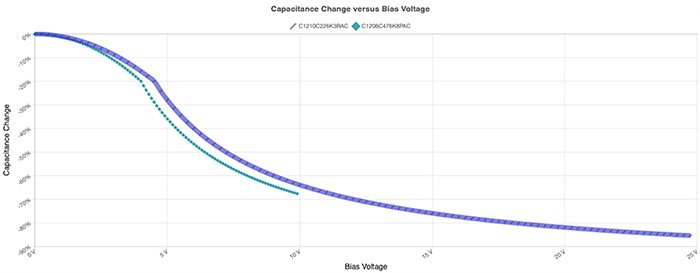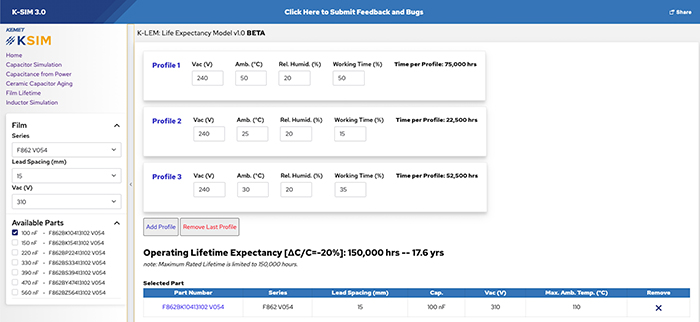Simulation and modelling provides the key to shorter design cycles
Numerous circuit design and simulation tools are now available free of charge online, provided by component suppliers. When selecting passive components, which are pushed routinely to their absolute limits in demanding applications, specialised tools provide the extra information engineers need to ensure optimum performance and reliability. Wilmer Companioni, Senior Technical Marketing Manager at KEMET.
From the earliest generations of design automation software, it has been clear that modelling and simulating – anything from electronic circuits to mechanisms and chassis/enclosures – has the potential to accelerate design cycles and reduce development costs. In the past, suitable tools have typically been expensive, the preserve of large companies that can afford to buy tools outright.
However, today many tools are accessed for free or on a pay-per-use basis, including those made available by component manufacturers. Among them are tools that can help make reliability predictions and assess performance at temperature and voltage extremes - providing engineers with affordable and comprehensive assistance to optimise their designs and select the most suitable components.
Today high-tech design often happens within smaller organisations or is carried out by small, focused design teams. Cashflow can be critically dependent on fast time to revenue, and as a result, budgets are tight, and design cycles short. These teams also tend to be specialists, without wide-ranging competencies under one roof. If a project calls for diverse design skills, spanning fields such as power; control; sensing; wireless; and even AI; the team may need to work with external consultants or reach out to partners and suppliers to help complete some parts of the project.
Designing an industrial robot, for example, could involve all these disciplines.
Where can you find free design tools?
Designing a power supply, bringing-up precision analogue circuitry such as an amplifier, or motor-control projects, are known to demand specialised knowledge. Chip manufacturers, sensitive to their customers’ needs, have published powerful tools that give designers a great start when choosing a suitable power converter topology, for example. By providing the desired input and output conditions, engineers can use tools to help choose a schematic and get recommendations on the right ways to use the selected parts.
Working entirely online, the designer can select and connect the components, select the values of external components such as the output capacitor and inductor, and quickly simulate the performance under various input and load conditions to verify the design. Several iterations can be tested quickly, without ever picking up a breadboard or soldering iron, to ensure that critical aspects such as the efficiency and transient response can meet the application’s needs.
Similarly, when designing an amplifier or small-signal filter, the websites of shortlisted IC suppliers can help identify a suitable circuit topology and critical components such as the amplifier IC type and capacitance values. Performance, such as the frequency response, is then easily simulated with a few clicks, and the circuit can be fine-tuned and re-tested as necessary before committing to building any hardware.

Above: Figure 1. The K-SIM tool helps predict capacitor behaviour under various conditions, such as DC bias
There are also tools available that help to assess other facets of circuit behaviour such as the die temperature of key components, which is vital to ensure the circuit achieves the desired reliability. With this information, you can adjust various factors such as the operating voltage or package type and assess the effects of load characteristics and ambient temperature. Simulating the effects of one or more changes quickly, without committing to hardware, can help avoid unwelcome surprises late in the project. In any engineering project, it’s always easier, faster, and more cost-effective to identify and solve problems earlier in the design cycle rather than later.
Distributors, as well as component manufacturers, are making design and simulation tools available online for customers to use, along with account space to store and share designs. Some, leveraging their connections with large numbers of manufacturers, also offer tools to automatically compile the bill of materials once the circuit is completed, and facilitate ordering components and scheduling deliveries. These extra labour-savers help distributors to build relationships and connect customers’ projects into their ecosystem. Some also offer finance and easy links to specialist design consultants and manufacturing services.
Overcoming limitations
Useful though this growing diversity of online tools can be, some aspects of the design may be left unaddressed. While you can quickly complete the design at a schematic level, based on a selected chipset, components that were previously an afterthought- such as passives - are being pushed further and further to meet the demands of today’s markets. As such, knowing simply the capacitance value and recommended voltage rating is often not enough to specify the ideal part for the application. Being able to simulate the performance of devices such as capacitors under extreme conditions is critical to shortening design cycle times.
KEMET’s K-SIM 3.0 parameter-simulation tool helps designers investigate the effects of temperature change, DC bias (Figure 1), frequency, and ripple on capacitor performance and find the information they need about reliability and ageing. The latest release contains several pre-built projects that help quickly set-up various scenarios to simulate. You can quickly adjust device parameters and search available parts to ensure the selected component has the desired parameters under the intended operating conditions.
K-SIM also incorporates the KEMET Life Expectancy Model (K-LEM), a first-of-its-kind life calculator that allows users to take temperature, humidity, and bias (THB) effects into account when working out capacitor lifetimes. Accurate lifetime calculations are needed to choose the right components to meet applicable reliability targets but can be difficult to achieve using datasheet information alone. The lifetime under expected THB conditions, for example, is impossible to predict. K-LEM lets you set up various environmental profiles and instantly calculates the lifetime of your chosen part in hours and years (Figure 2). There are also tools for calculating the inductor core losses and lifetime of aluminium electrolytic capacitors.

Above: Figure 2. the KEMET Life Expectancy Model helps make lifetime predictions that are otherwise impossible to calculate
The KEMET Engineering Center has other tools ready to download, such as the FIT (failures-in-time) calculator. This calculator is based on established military reliability prediction practice and lets you assess components of various types and ratings according to the application temperature and voltage. You can also tackle challenges such as selecting the best holdup capacitors for a solid-state disk application by downloading the SSD Configuration Calculator. This simple Excel spreadsheet helps ensure your chosen component not only has suitable capacitance but also helps select the footprint and ensure sufficient stored energy to supply the SSD.
In addition, the KEMET Engineering Center is a source of helpful information such as technical papers on capacitor properties and characteristics, the latest component technologies, and application notes with design and selection guidance.
Conclusion
Taking advantage of online design tools and simulators is the modern way to create new products and essential to keep pace with competitors, accelerate time to market, and minimise costs. Time invested in learning how to use the tools and where to find component-specific tools like capacitor reliability calculators is well-spent. Calculating lifetime and ageing is important, but KEMET is one place to provide it. Just as technology changes, so, too do the demands placed on design tools. The facilities provided through the KEMET Engineering Center will continue to adapt to the needs of design engineers.










